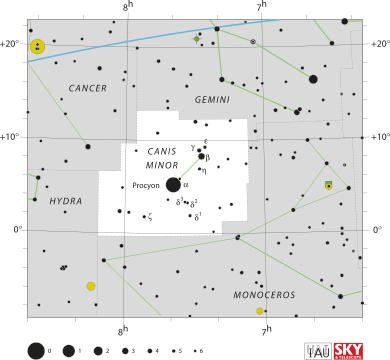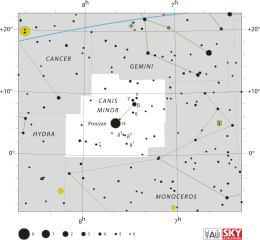Canis Minor facts for kids
| Constellation | |

List of stars in Canis Minor
|
|
| Abbreviation | CMi |
|---|---|
| Genitive | Canis Minoris |
| Pronunciation | genitive |
| Symbolism | the lesser Dog |
| Right ascension | 8 |
| Declination | +5 |
| Quadrant | NQ2 |
| Area | 183 sq. deg. (71st) |
| Main stars | 2 |
| Bayer/Flamsteed stars |
14 |
| Stars with planets | 1 |
| Stars brighter than 3.00m | 2 |
| Stars within 10.00 pc (32.62 ly) | 4 |
| Brightest star | Procyon (α CMi) (0.34m) |
| Messier objects | 0 |
| Meteor showers | Canis-Minorids |
| Bordering constellations |
|
| Visible at latitudes between +90° and −75°. Best visible at 21:00 (9 p.m.) during the month of March. |
|
Canis Minor is a small constellation in the northern sky. Its name comes from Latin, meaning "the smaller dog" or "the lesser dog." It is often seen as one of the two hunting dogs following the great hunter Orion in the night sky.
Contents
History of the Little Dog Constellation
People have been looking at the stars for a very long time! The first known records of Canis Minor come from ancient Greece. Around 1,800 years ago, a famous astronomer named Ptolemy wrote about Canis Minor. He included it in his star book called "Almagest."
Ptolemy's work helped make Canis Minor an official constellation. This means people have recognized this "little dog" pattern for most of recorded history. Imagine, those stars have been shining for thousands of years!
Brightest Stars in Canis Minor
Even though Canis Minor is small, it has two very bright stars. You can easily spot them on a clear night.
Procyon: The Leading Star
- Procyon (α CMi): This is the brightest star in Canis Minor. It is also the eighth-brightest star in the entire night sky! Its name comes from a Greek word meaning "before the dog." This is because Procyon rises before Sirius, which is the brightest star in Canis Major.
Procyon is a binary star system. This means it is actually two stars orbiting each other. The main star, Procyon A, is a yellow-white star. It is a bit bigger and heavier than our own Sun. Procyon A is about 11.46 light-years away from Earth. This means the light we see from Procyon today left that star over a decade ago!
Its partner star, Procyon B, is much smaller and fainter. It is a white dwarf star. White dwarfs are what is left of stars that have used up all their fuel. Procyon B is super dense. It has about the same mass as our Sun, but it is squeezed into a space about the size of Earth.
Gomeisa: The Blue-White Star
- Gomeisa (β CMi): This is the second-brightest star in Canis Minor. Gomeisa is a blue-white star. It is farther away than Procyon, about 160 light-years from Earth. The name "Gomeisa" might come from an Arabic word, but its exact meaning is not clear.
Gomeisa is a very hot and bright star. It is much hotter than our Sun. It also gives off a lot more energy. Because of its high temperature, it looks bluish-white.
Other Interesting Facts About Canis Minor
While Procyon and Gomeisa are the main stars, Canis Minor has other fainter stars. These stars are harder to see without binoculars or a telescope. They help make up the full shape of the constellation.
Unlike some bigger constellations, Canis Minor does not have any Messier objects. Messier objects are a list of interesting things in space. These include nebulae (gas clouds), galaxies, and star clusters. You can usually see them with amateur telescopes. This does not make Canis Minor less important. It just means its beauty comes from its bright stars and its place in sky stories.
Canis Minor also does not have any very bright nebulae or galaxies. These are not easy to see with small telescopes. But astronomers are always learning new things about space. There is still so much out there for us to discover!
Finding Canis Minor in the Night Sky
It is easiest to find Canis Minor by first looking for Orion. Orion is one of the easiest constellations to spot. It has three bright stars that form Orion's belt.
From Orion's belt, look down and slightly to the left. You will see the very bright star Sirius. Sirius is in the constellation Canis Major. Just above and to the west of Sirius, you will find Procyon. Procyon is the brightest star in the slightly smaller Canis Minor. Remember, finding constellations is easier on dark nights, away from city lights.
Mythology and Stories of the Little Dog
Many cultures have their own stories about Canis Minor. In Greek mythology, it is often one of the hunting dogs that go with Orion. The most popular story says it is Laelaps. Laelaps was a very fast dog given to a woman named Europa.
The god Zeus felt sorry for Laelaps. So, he turned the dog into a constellation. This way, Laelaps would always have a place among the stars!
Images for kids
-
Canis Minor, as drawn by Johann Elert Bode in 1801.
-
The constellation Canis Minor can be seen with Monoceros in this 1825 star chart.
See also
 In Spanish: Canis Minor para niños
In Spanish: Canis Minor para niños




